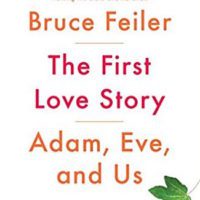Adam and Eve are the Bible’s most infamous couple: Bonnie and Clyde, year zero. The first sinners went big, lying to God’s face and then literally raising Cain, the original murderer. Over the course of centuries, male scholars and theologians have used Adam and Eve’s story to prove that women are at best the secondary sex, and at worst the weaker one—prone to emotion over intellect, easily swayed by the devil, and agents of temptation themselves. Not only did the concept of sin come from Adam and Eve, so too did Western ideas about patriarchy, heteronormativity, guilt, and a twisted taboo about intercourse, since the language of Genesis implies “eating of the fruit” may symbolize something more unsavory than simply biting an apple.
These were the many negative associations I brought to Feiler’s The First Love Story, which I picked up expecting to put back down after a few pages. I was surprised to find The First Love Story working against my assumptions in the best ways. The author’s tone is iconoclastic and curious, not reverential and dour. Instead of examining a stale myth, Feiler shows how Adam and Eve have always been and continue to be mutable, rebooted through the ages to suit their times like comic book superheroes. By investigating the history of these re-imaginings, Feiler tracks the evolution of how people have thought about relationships between humanity and God. He focuses on the artists and intellectuals who have subverted mainstream religious dogma and found, in Adam and Eve, radical inspiration for what it means to be human, and what it means to love—which are the same thing, really.
Some of this revolutionary work stares us in the face, culturally speaking. Probably the most famous artwork about the first couple is Michelangelo’s depiction of Creation on the ceiling of the Sistine Chapel. Feiler describes how, after the death of Jesus Christ, early religious leaders like Paul contrasted Adam and Jesus, the former being a sinner of the Earth and the latter a divine figure from heaven. Similarly, a connection formed between Eve and Mary, one in which dutiful Mary heals Eve’s break with God—this is the reason why, if you look closely at church statuary, you’ll often find a serpent twisting beneath Mary’s bare feet. To gaze upon Eve’s folly was to remember Mary’s virtue, a mystical connection exemplified in Michelangelo’s Renaissance-era masterwork.
In the chapel’s most famous, seemingly male-centric image, God reaches his index finger to touch Adam’s, symbolically giving him life. Yet the creator’s other arm drapes over Eve, holding her to his chest. Locate the exact center of the ceiling and you won’t find God, Jesus, or Adam, but instead Eve’s face and torso. In the panel depicting their temptation, Adam appears to be reaching for the taboo fruit just as much as his partner, who sits curled around his legs, her head directly next to his semi-erect penis—an image the Vatican considered so scandalous, it wasn’t reproduced for centuries. And Eve isn’t alone. For every male patriarch on the walls, Michelangelo includes a woman, illustrating the importance of duality and cooperation, not hierarchy. After twice having the rare privilege of viewing the chapel in near solitude (a treat many pay thousands of dollars for), Feiler writes:
No longer did I view it as a temple of maleness, a place where God and Adam effortlessly assert their patriarchal control over the world. No longer did I view Adam as the central figure in the room and Eve the forgotten one. Instead I saw the chapel as a bulwark against those ideas, a corrective to centuries of belittling Eve. I saw it as a restoration of the idea that Adam and Eve share credit—and blame—for what happened in Eden.
Almost two hundred years later, in 1667, English writer John Milton took Eve’s equality even further in his narrative poem Paradise Lost. Unhappily married not once but three times, Milton believed that, at its heart, marriage was about a meeting of independents who enhance one another’s life—not necessarily with children, but with companionship and assistance. After all, God created Eve to soothe Adam’s loneliness; the creator’s command to “be fruitful and multiply” came later.
In Milton’s retelling, when Eve bites the fruit, she’s motivated by intellectual desire—the serpent has promised it will endow her with the wisdom and knowledge of God, and Eve can’t understand why God would want to keep that from her. Realizing that the fruit has made her different from her husband, she considers lording over him, but instead offers him a bite so that he may see as she sees and know what she knows. Adam has a choice—remain in the garden with God, or sin and stick with Eve. He chooses to break with God because his love for Eve is greater. Far from being a deplorable figure, Eve shows Adam how to utilize God’s greatest gift: free will. In this way, Feiler writes, “Eve is the first teacher, the first to trust her eyes, the first who wants to know. In so doing, she becomes the first to commit the ultimate modern act of not accepting the meaning of others but instead on making meaning yourself. She writes her own story.” By depicting Adam and Eve as two autonomous people entering into a union, choosing to stay in cahoots, living and working together, Milton’s poem represents a shift toward a more modern conception of love, one based on fair partnership.
If all of this rooting through old stories and art sounds a bit dry, it isn’t. Feiler (whose 2001 bestseller Walking the Bible: A Journey by Land through the Five Books of Moses is part spiritual quest, archaeological trek, and adventure story—think Indiana Jones meets Thomas Merton) adeptly breaths life into what might have been a dusty intellectual history. He travels around the world, from the junction of the Tigris and Euphrates rivers in war-torn Iraq that formed the borders of Eden; to a California clothing collection that includes a corset wore by Mae West, whose risqué portrayal of Eve in a radio drama set off an early twentieth century culture war; to the Galápagos Islands, one of which was settled by a German couple in 1929 who sought “to recreate the lives of Adam and Eve, right down to the naked farming.” Along the way, Feiler thumbnails numerous luminaries inspired by the first couple, such as suffragette firebrand Elizabeth Cady Stanton, who in the late 1800s decided that preachers, not politicians, presented the biggest obstacle to women’s liberation, and so rewrote the first five books of the Bible from a feminist perspective. Feiler’s chapters are stuffed with interesting people and concepts. They move briskly, delving into every iconic moment in the first couple’s short tale, each an opportunity to examine a different wrinkle of love: collegial, romantic, sexual, familial, extramarital, the blush of youth, the pale of twilight. I sometimes wished he’d slow down and settle for a bit longer, though doing so might have yielded a Bible-length tome.
The most powerful aspect of The First Love Story is how it positions Adam and Eve as role models for romantics and rebels both. Even in the Fertile Crescent, their story symbolized a paradigm shift in human consciousness, coming about at a time when society was transitioning from tribal, nomadic hunting and gathering to agriculture. It’s from here that our belief in pair-bonding originates, the dream that somewhere out there is another human who completes you, an idea still very much at the heart of our culture.
Feiler’s book posits that perhaps not much has changed since Adam and Eve’s time, even though everything has changed. And maybe this is why, when we look at them, we see ourselves, though Feiler suggests what self we see depends on what we’re looking for. View the world as a grim power struggle, a battle of the sexes, and you’ll find grist for tragedy. But open your mind and you may find that love is love is love, and has been since the dawn of civilization. Love isn’t a tool of oppression, it’s “a story we tell with another person,” a story that enriches and gives meaning to our lives. Lovers like Adam and Eve may at times break society’s rules, but in doing so they always fulfill God’s intention: a human’s best self is a social self, living not alone but together, in love.




